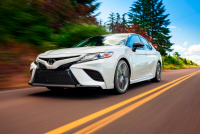For the last four years, the XV50 series, the epitome of the Japanese business sedan, has been on sale in Europe. Now everything will change: there are no more 'American' or 'Japanese' cars, but there is one for all Toyota Camry XV70 on a new platform. Sales in America began last summer and in Russia the certification process is nearing completion - the new Toyota Camry will arrive in dealerships in April. I was able to drive the Camry in the US - and I hope that the car being prepared for production at the plant in St Petersburg will leave similar impressions.
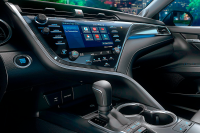
The aftermath of an accident - or is it meant to be? You have to look closely to find out. It turns out that the huge "cracks" in the bumper under the rear lights are pseudo-deflectors, and along with the four exhaust shafts, these are the hallmarks of the "sporty" SE and XSE versions.
The decorative 'gills' on the rear bumper are almost invisible on dark-coloured bodies, but light-coloured sedans will long be
Actually, the Camry now has two faces. The good face is the base versions L, LE and XLE with a wide false radiator grille (these will be sold in Europe) and the evil one - XSE and SE. But if "American" is equipped with eight-speed "automatic" and new "four" 2.5, the Camry will remain the old power-unit - 2AR-FE engine of the same 2,5 liters with a six-speed "automatic". The two-litre 6AR-FSE engine will also remain.

The crowning touch
In 1979, the Japanese decided to take the body from the Carina sedan, styling from the Celica coupe - and turned it all into a sports modification of the Celica Camry, where the second name was a westernised version of the Japanese word 'can-mun-ri', that is 'crown'. But hardly anyone guessed that three decades later this very name would become one of the synonyms of the Toyota brand! Tiara, Corona, Crown, Corolla - as different variations of the same "crown" totem stuck in Toyota's sanctuaries. Even after separation into independent family at the end of 1983, Camry has remained just another Toyota for a decade and a half.
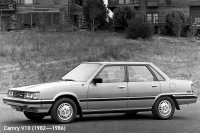
That was until 1996, when the Toyota Camry XV20 was introduced. The model was touted as the first serious figment of the kaizen philosophy, and Toyota's advertising and PR people went to great lengths to get America talking about kaizen as a new industrial religion. To this day, the Camry's success is believed to be based on quality, reliability and comfort, though of course, it's all about price. More precisely, the kaizen is also a cost-cutting philosophy. Toyota has drastically reduced the range of "unique" components, refused the station wagon version - and the price of XV20 sedans is beyond competition. Toyota has dared then to release "dummy" version L (without music, power windows and an air conditioner), but only for 16880 dollars!
The next year, 1997, the Toyota Camry finished first in the rank of America's number one passenger car and over the next 20 years lost the throne just once (in 2001, the bestseller for the last time was the Honda Accord).
In Europe Camry has other status: a business sedan for those, whose life is almost successful. However, this image has been gained almost by the same methods as in America.
It all began in 2002. We had Camry XV30 series, which Toyota promoted as the first car on a new K-platform, though the chassis was virtually the same, and innovations were limited to changes in appearance and interior. But if in 1998 Camry in Europe cost 46 thousand dollars, in four years they asked $36800 for top-version with V6 engine, and only $26 thousand for base sedan!
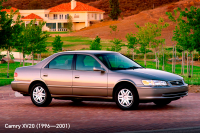
Following the results of twelve months, Toyota has beaten competitors one and a half times then, the next four years the sales volume has grown ten times more - and since then leadership in the so-called business class market has remained undisputed. "You don't know what to get, get the Camry!"
I also tell you this because with the new Camry, the opposite seems to have happened: there's no reason to expect Toyota to conquer.
The Camry has already changed eight generations in 35 years, and in addition to Japan, the US, China, India and several Southeast Asian countries have also appeared on the production map. Camry is produced in America since 1988, in China since 2006, and assembly in St. Petersburg began in 2007. There was also an Australian plant, but Toyota closed it in 2016, though that is where the cars were shipped to the Middle East, where the Camry is also very popular. In Europe, on the other hand, the large Japanese sedan was not well-liked, so Toyota phased out sales back in 2004
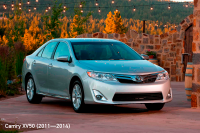
Tight jacket
Inside the Camry, one understands that marketing experts have set a goal to expand an audience at the expense of younger buyers not to lose the old ones, but God forbid not to draw away adherents of Lexus brand - and first of all, sedan ES 250.
Interior is executed with taste, and details bribe: wells of devices with emotional illumination of scales (it can be even red), fugery bend of the central console, elegant keyboard on a steering wheel, figured under wheel levers and paddles of manual gear selection, floor accelerator pedal. Even the secondary buttons to the left of the steering wheel, though remaining large, no longer look like aliens from a bygone era.
Gone is the annoying clock with its calculator display and fluorescent glow. From now on, the time is displayed in large numerals in the upper section of the multimedia system screen. The screen itself settles on a glossy island with an amalgamation of aluminium fins, while in the more expensive versions the large screen is built into the bezel-less panel. The system can be augmented with options such as internet distribution and remote vehicle monitoring via a smartphone app. In my Camry, however, the screen was the simplest and the menus the most mundane.
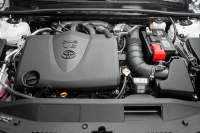
The main ergonomic innovation on the centre console is the volume knob and radio frequency knob, located on the driver's side. And what about heated seats' buttons! Next to the automatic selector there is a "keyboard" to select modes of transmission (Eco, Normal and Sport). "Base in Camry has one-zone climate control, for extra charge - two-zone and Entune 3.0 stereo system with JBL speakers, Wi-Fi-router and CD-player.
The upper part of the front panel is made of quality and soft plastic. The floor below - decorative inserts (it can be veneer, leather or metallized plastic), and the general pattern is as follows: the closer to your feet, the cheaper the materials are. Alas, it also concerns plastic, which surrounds a selector of a gearbox. The handle itself looks more solid than before, but, as well as before, it does not pull to hold it with your hand.
 Attention to details most of all distinguishes new Camry from its predecessor, even if to speak about deflectors or door handles.
Attention to details most of all distinguishes new Camry from its predecessor, even if to speak about deflectors or door handles.
In general, all changes are rather evolutionary, expected, and the real - and, alas, not the most pleasant - surprise became a narrower rear sofa.
In spite of the fact that the wheelbase was stretched by 49 mm (to 2824 mm), the distance between the rows was reduced by 23 mm! Most likely due to the fact that the new architecture of TNGA implies the lowest possible centre of gravity, and hence the lowering of the seats: the front seats are lowered by 25 mm, and the rear sofa - by 30 mm. The increase in wheelbase did not bring additional volume, because most of it is explained by shifting the front axle closer to the nose for the sake of harmonious proportions of the body. Recall that the TNGA (Toyota New Global Architecture) platform debuted in 2015 on the Prius, and the Camry is based on a scaled-down variation of it. The main differences from the previous K-platform are a double wishbone rear suspension instead of McPherson struts, a 30% increase in body rigidity, a lowered centre of gravity and reduced ground clearance from 155mm to 145mm.
The key features of the new TNGA platform are the rack-and-pinion electric power steering and a double wishbone rear suspension on a massive subframe.
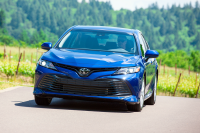
In America, the spaciousness of the cabin is judged by its volume, and it became less: 2.84 cubic meters against the previous 2.91. Minus 70 litres, and it is half a volume of a human body. Moreover, if a front seat is lowered to the limit, the feet of a rear passenger will become cramped.
In those regions where the Camry has developed an image of a business sedan, Toyota still offers a rich "command console" for the rear seat. These pictures show the equipment in the Chinese Camry. Almost all buttons became touch screen, but the functionality is the same: climate control, "music", heated sofa and backrest tilt adjustment.
The boot also became smaller: 428 instead of 436 litres (according to American EPA standard). With trimming materials it is like Toyota - simple, accurate, but without smart solutions. There is even no internal handle of a boot! Though the rails of a lid are finished with plastic, they still take away a part of useful space, and the floor forms step at the place where backs of seats begin. As before, the seats can be folded remotely, with the levers with rods, and under the floor in the American version is an organizer with tools.
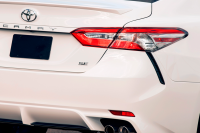
Volume of a boot in specification, obviously, will be the same as in cars for Ukraine: 493 liters instead of 506
Henceforth Camry is not an old-fashioned double-breasted jacket but fashionable fitted one, assuming that the owner is ready to tighten a belt for one more hole.
Steer and twist
American roads are not the best ground for estimation of driving qualities. Everything here is "straight, perpendicular and painted". I didn't find any running corners or serpentines in Miami, but still I'm ready to assert, that the new platform has gone for good.
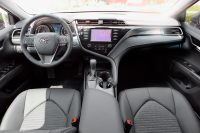
The steering ratio is reduced from 14.8:1 to 13.8:1 (the steering wheel makes 2.65 turns from stop to stop instead of 2.85), though the turning circle grew due to the increased base. Steering has become more exact, pleasant, though excitement, as before, is not the question. And Camry still holds a straight line superbly.
It seems that now it handles the bumps more tightly, but in general comfort remained at a decent level, and its acoustic component has definitely improved: it is quiet!
The new atmospheric A25A-FKS engine has increased piston stroke and reduced diameter. Compression ratio is increased from 10.4:1 to 13:1, the hydraulic intake phase shifter has been replaced with an electric phase shifter, and the injection system is combined (intake manifold and direct injection into the cylinders).
This engine has yet to prove its reliability, although since Toyota first used it in the Camry, we must assume that everything has been tested and proven. On the other hand, not only in Europe, but also in many other countries, the Camry XV70 series will make its debut with the old engines...
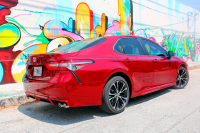
The new eight-speed 'automatic' Direct Shift - 8AT is used in all American Camry. It's 5 mm shorter than the six-speed thanks to a different planetary train and a new torque converter with an earlier lockup. The powerband has been increased and according to Toyota, it exceeds the value of 8.0. In Europe such "automatic" will be offered only on Camry with V6 engine
I like the new engine 2,5, moreover together with prompt eight speed automatic device very much. Especially since for the XSE version the torque has been increased from 249 to 252 Nm (206 and 209 hp respectively). Maximum output of the 2.5 quad is now achieved at higher revs - and it's a shame that this 'torsional' character won't freshen up the driving image of the European Camry.
The Camry's 3.5 engine will be almost identical to the American unit. It is the same modernized "six" 2GR-FKS, but downgraded from 301 hp to 249 hp.
The V6 3.5 engine in the new Camry for the US has also been upgraded: the phasing unit has been changed and there is a similar dual-injection system. Henceforth it produces 301 hp instead of 272 hp, but American press, as before, does not see real sporty charge in it: in comparative tests, Camry 3.5 loses in acceleration dynamics to new Accord with turbo 2.0 motor and ten-speed automatic. However, we'll check it on occasion: A Camry with V6 engine will appear in Europe with a new motor and a new eight-speed automatic.
According to Rospatent, in Europe Camry will not have two-color variant, aggressive front end, pseudo-deflectors on a rear bumper and sports exhaust system. Production at the plant in Shushary has already started with the XV70 prototypes. Full-scale production will be launched at the end of March and sales will start in April.
In the US prices start at $23495 (excluding tax, dealer commission and shipping). That's 425 more expensive than before, but by the end of 2017, the Toyota Camry was once again the best-selling passenger car in the US! Only the Toyota RAV4 and Nissan Rogue (aka X-Trail) crossovers and, of course, full-size pick-up trucks are more popular.
As for prices in Europe, we can still be guided by Ukraine: the Toyota Camry 2.5 has become about $700 more expensive - and costs from $27989 to $37289.
